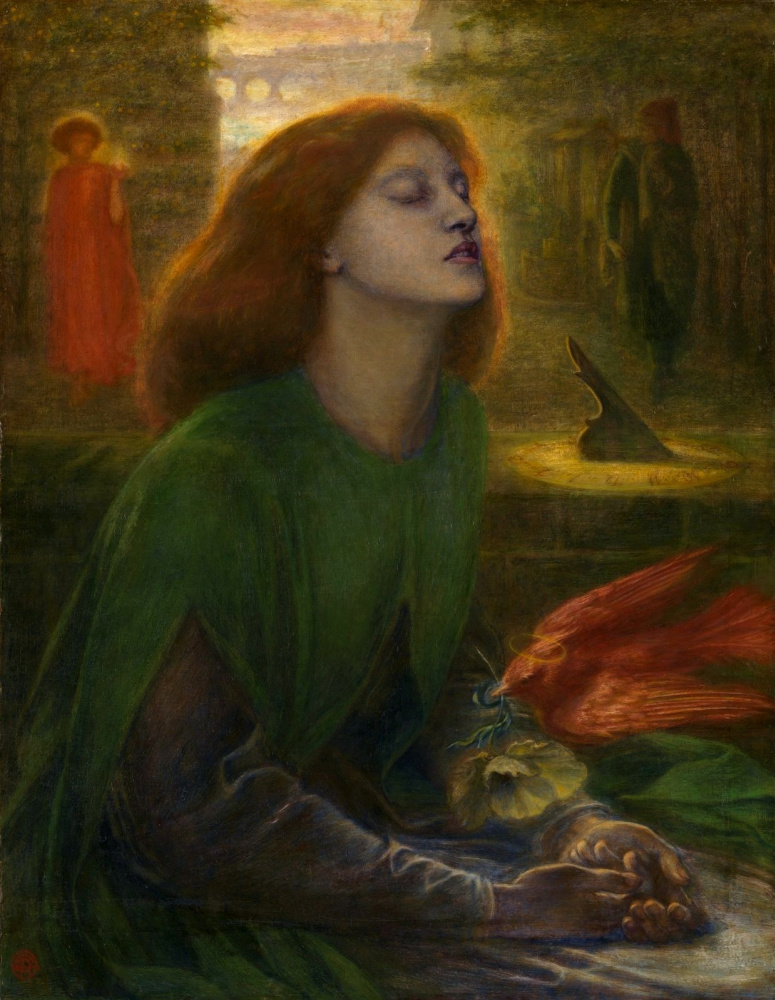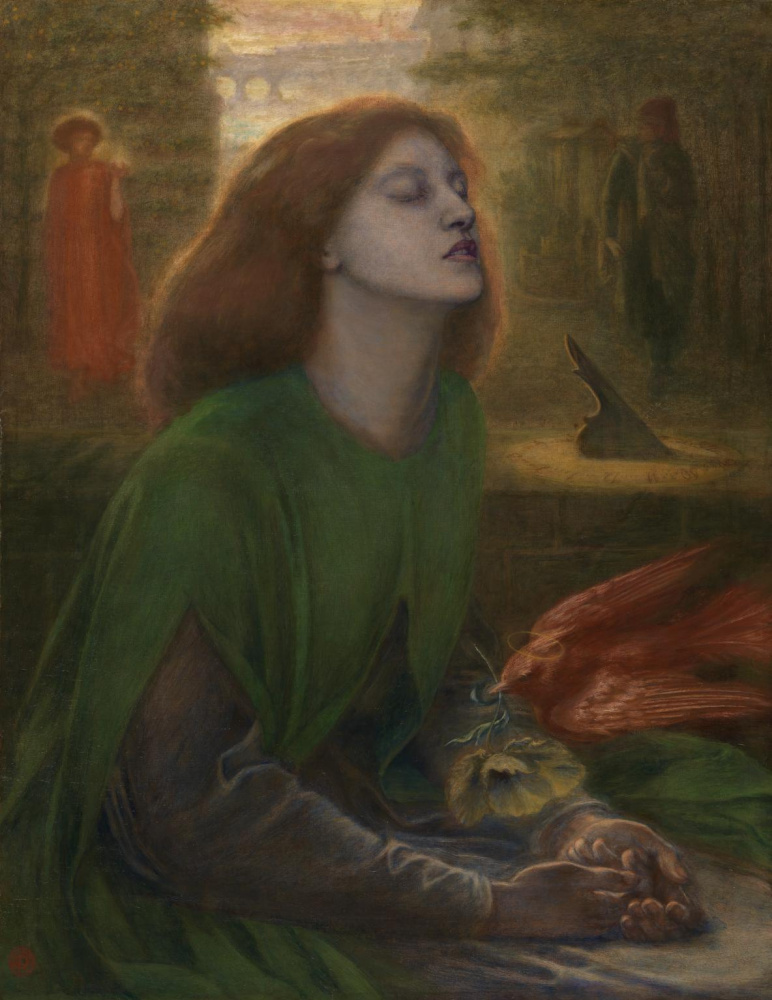log in
Enter site
Login to use Arthive functionality to the maximum
Blessed Beatrice
Dante Gabriel Rossetti • Painting, 1870, 86.4×66 cm
Description of the artwork «Blessed Beatrice»
Laudanum is an opium spirit tincture, which in Victorian England was considered the panacea for all diseases. And above all, sedative, analgesic and hypnotic. Dante's wife, Gabriel Rossetti, was 33 years old when she took a lethal dose of laudanum: either she simply exceeded her allowable dose of medicine, without which she had not done the last few years, or she deliberately committed suicide.
"Blessed Beatrice" Rossetti wrote shortly after the death of Elizabeth Siddal from sketches and drawings, which he made hundreds during their life together. Elizabeth worked in a hat shop when the artist saw her Walter Deverell, who entered the shop by chance with his mother. After this meeting, he told Holman Hunt and Rossetti: “She is like a queen: magnificently tall, with a beautiful figure, a magnificent neck, a gentle face, a smooth transition of lines from the temples to the cheekbones exactly resembles the sculpture of the goddess Phidias ... Wait, I have not finished yet! She has gray eyes, and her hair is like sparkling copper and shimmers when she dissolves them. ”. Pre-Raphaelite artists found the ideal model, as if descended from the early Renaissance frescoes - Millet wrote from her Ophelia, Hunt - Sylvia. Then Lizzy introduced Rossetti - and she became his personal model, mistress, and soon a student. For 10 years they lived together - temperamental, passionate, quick-tempered, talented, both poets and artists. Dante painted her obsessively, every day, her face looked from each sketch and canvas in his mother. Elizabeth was sick with tuberculosis, frequent attacks laid her for a long time in bed, after some time the curved spine began to cause attacks of neuralgia - then opium tincture was in her hands. In 1860, when the state of the girl was critical, a desperate Rossetti decided to marry her. He felt guilty because he did not dare to do this before, and he could not boast of loyalty in this 10-year relationship. And suddenly the meaning of his life, his beloved, his model, his Beatrice - at death.
Elizabeth Rossetti felt better after the wedding, but lived in marriage only two years. These were not at all cloudless relations between the muse and the inspired poet, marred, moreover, by miscarriage, insomnia, drug addiction. In 1862, Lizzy took a deadly dose of laudanum — either wanting to alleviate the unbearable pain, or she decided to get rid of the pain forever. And the widowed artist conceived "Blessed Beatrice"on which will work 6 years.
Beatrice is an image that Lizzy completely belonged to in the work of Rossetti. She posed for “Meet Dante and Beatrice in Paradise”, "Sleep Dante on the death of Beatrice", "Beatrice Greetings". And now Rossetti writes it at the moment of parting with the world - in a blissful and humble acceptance of the end. The dove puts a poppy in her open palm - a symbol of death. Behind her shoulders, an angel of love, dressed in red, holds a dying fire - a symbol of dying life. The second figure is Rossetti himself in the image of Dante, who is no longer able to hold his beloved on the ground. In one of the letters, the artist said that he sought not to depict death, but to replace it with a certain state of trance, in which Beatrice is transferred from earth to heaven.
John Ruskin said about the unusual property of light in the works of Rossetti in the 60s: “His light is not the sunlight itself, but the sunlight scattered through colored glass”. The first impression of “Blessed Beatrice” is exactly this: the light radiates the entire figure of the girl, her hands and the hem of the dress, her shining hair shines from the inside, and not highlighted by an external source, the sun from a distant city.
After the death of Elizabeth Rossetti could not live in their common home - and moved. “Blessed Beatrice” he will repeat a few more times (mainly receiving an order for this particular image). With each new remark, the light in Beatrice’s hands and hair will be increasingly uncertain and dull, as will the memories of Elizabeth being driven out of Rossetti’s life by new women, opium and whiskey.
Author: Anna Sidelnikova
"Blessed Beatrice" Rossetti wrote shortly after the death of Elizabeth Siddal from sketches and drawings, which he made hundreds during their life together. Elizabeth worked in a hat shop when the artist saw her Walter Deverell, who entered the shop by chance with his mother. After this meeting, he told Holman Hunt and Rossetti: “She is like a queen: magnificently tall, with a beautiful figure, a magnificent neck, a gentle face, a smooth transition of lines from the temples to the cheekbones exactly resembles the sculpture of the goddess Phidias ... Wait, I have not finished yet! She has gray eyes, and her hair is like sparkling copper and shimmers when she dissolves them. ”. Pre-Raphaelite artists found the ideal model, as if descended from the early Renaissance frescoes - Millet wrote from her Ophelia, Hunt - Sylvia. Then Lizzy introduced Rossetti - and she became his personal model, mistress, and soon a student. For 10 years they lived together - temperamental, passionate, quick-tempered, talented, both poets and artists. Dante painted her obsessively, every day, her face looked from each sketch and canvas in his mother. Elizabeth was sick with tuberculosis, frequent attacks laid her for a long time in bed, after some time the curved spine began to cause attacks of neuralgia - then opium tincture was in her hands. In 1860, when the state of the girl was critical, a desperate Rossetti decided to marry her. He felt guilty because he did not dare to do this before, and he could not boast of loyalty in this 10-year relationship. And suddenly the meaning of his life, his beloved, his model, his Beatrice - at death.
Elizabeth Rossetti felt better after the wedding, but lived in marriage only two years. These were not at all cloudless relations between the muse and the inspired poet, marred, moreover, by miscarriage, insomnia, drug addiction. In 1862, Lizzy took a deadly dose of laudanum — either wanting to alleviate the unbearable pain, or she decided to get rid of the pain forever. And the widowed artist conceived "Blessed Beatrice"on which will work 6 years.
Beatrice is an image that Lizzy completely belonged to in the work of Rossetti. She posed for “Meet Dante and Beatrice in Paradise”, "Sleep Dante on the death of Beatrice", "Beatrice Greetings". And now Rossetti writes it at the moment of parting with the world - in a blissful and humble acceptance of the end. The dove puts a poppy in her open palm - a symbol of death. Behind her shoulders, an angel of love, dressed in red, holds a dying fire - a symbol of dying life. The second figure is Rossetti himself in the image of Dante, who is no longer able to hold his beloved on the ground. In one of the letters, the artist said that he sought not to depict death, but to replace it with a certain state of trance, in which Beatrice is transferred from earth to heaven.
John Ruskin said about the unusual property of light in the works of Rossetti in the 60s: “His light is not the sunlight itself, but the sunlight scattered through colored glass”. The first impression of “Blessed Beatrice” is exactly this: the light radiates the entire figure of the girl, her hands and the hem of the dress, her shining hair shines from the inside, and not highlighted by an external source, the sun from a distant city.
After the death of Elizabeth Rossetti could not live in their common home - and moved. “Blessed Beatrice” he will repeat a few more times (mainly receiving an order for this particular image). With each new remark, the light in Beatrice’s hands and hair will be increasingly uncertain and dull, as will the memories of Elizabeth being driven out of Rossetti’s life by new women, opium and whiskey.
Author: Anna Sidelnikova



